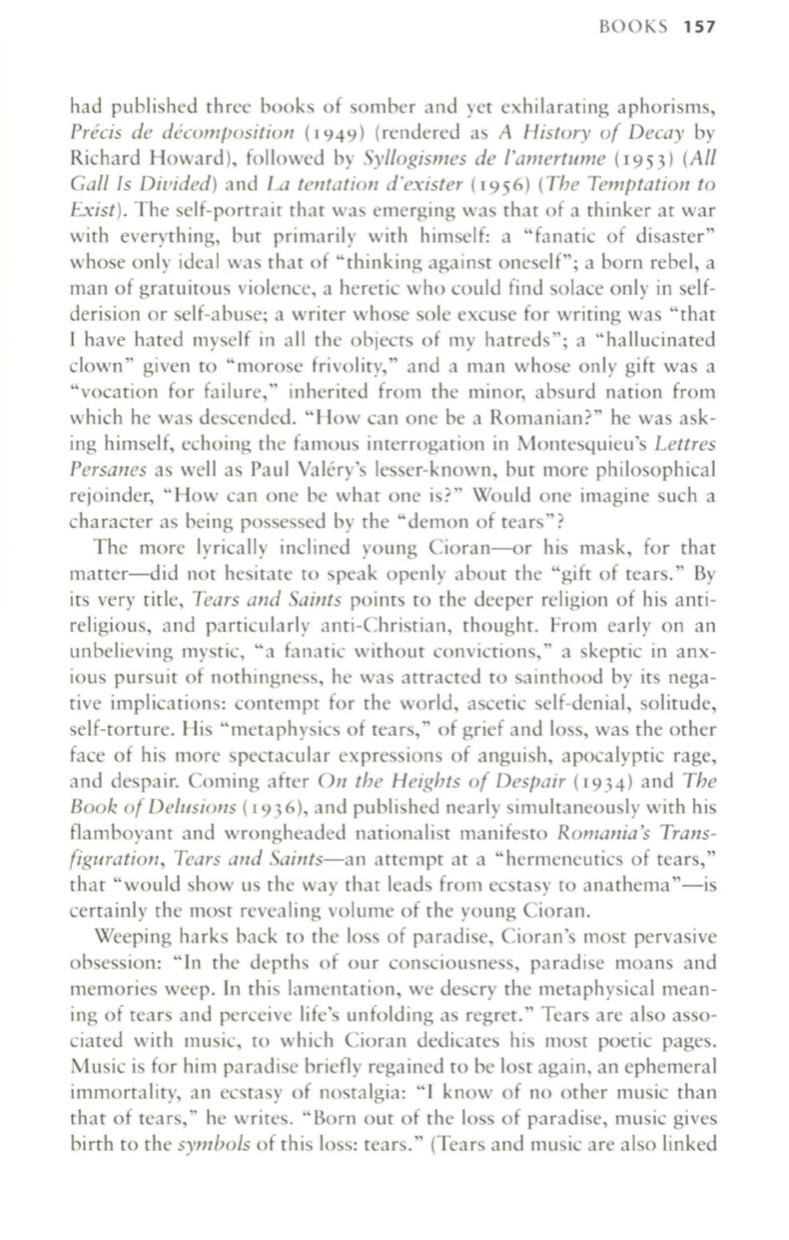
BOOKS
157
had published three books of somber and yet exhilarating aphorisms,
Precis de decomposition
(1949)
(rendered as
A History of Decay
by
Richard Howard), followed by
Syllogismes de l'amertume
(1953)
(All
Gall Is Divided)
and
La tentation d'exister
(1956)
(The Temptation to
Exist).
The self-portrait that was emerging was that of a thinker at war
with everything, but primarily with himself: a "fanatic of disaster"
whose only ideal was that of "thinking against oneself"; a born rebel, a
man of gratuitous violence, a heretic who could find solace only in self–
derision or self-abuse; a writer whose sole excuse for writing was "that
I have hated myself in all the objects of my hatreds"; a "hallucinated
clown" given to "morose frivolity," and a man whose only gift was a
"vocation for failure," inherited from the minor, absurd nation from
which he was descended. "How can one be a Romanian?" he was ask–
ing himself, echoing the famous interrogation in Montesquieu's
Lettres
Persanes
as well as Paul Valery'S lesser-known, but more philosophical
rejoinder, "How can one be what one is?" Would one imagine such a
character as being possessed by the " demon of tears"?
The more lyrically inclined young C ioran-or his mask, for that
matter-did not hesitate to speak openly about the "gift of tears." By
its very title,
Tears and Saints
points to the deeper religion of his anti–
religious, and particularly anti-Christian, thought. From early on an
unbelieving mystic, "a fanatic without convictions," a skeptic in anx–
ious pursuit of nothingness, he was attracted to sainthood by its nega–
tive implications: contempt for the world, ascetic self-denial, solitude,
self-torture. His "metaphysics of tears," of grief and loss, was the other
face of his more spectacular expressions of anguish, apocalyptic rage,
and despair. Coming after
On the Heights of Despair
(I934)
and
The
Book of Delusions
( 1936),
and published nearly simultaneously with his
flamboyant and wrongheaded nationalist manifesto
Romania's Trans–
figuration, Tears and Saints-an
attempt at a "hermeneutics of tears,"
that "would show us the way that leads from ecstasy to anathema"-is
certainly the most revealing volume of the young Cioran.
Weeping harks back to the loss of paradise, Cioran's most pervasive
obsession: "In the depths of our consciousness, paradise moans and
memories weep. In this lamentation, we descry the metaphysical mean–
ing of tears and perceive life's unfolding as regret." Tears are also asso–
ciated with music, to which Cioran dedicates his most poetic pages.
Music is for him paradise briefly regained to be lost aga in, an ephemeral
immortality, an ecstasy of nostalgia: "I know of no other music than
that of tears," he writes. "Born out of the loss of paradise, music gives
birth to the
symbols
of this loss: tears." (Tears and music are also linked


